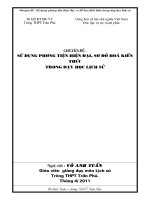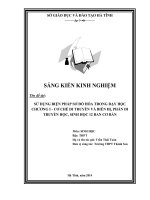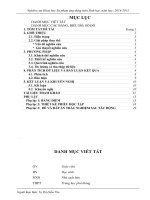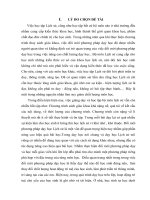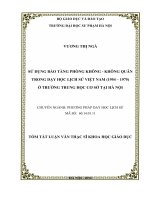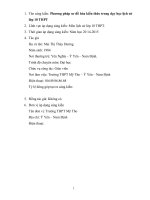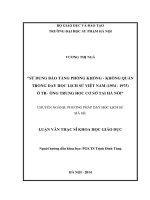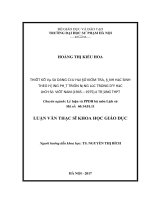Phương pháp sơ đồ hóa kiến thức trong dạy học lịch sử việt nam (1919 1975) ở trường trung học phổ thông (thực nghiệm sư phạm tại vùng tây bắc ) tt tiếng anh
Bạn đang xem bản rút gọn của tài liệu. Xem và tải ngay bản đầy đủ của tài liệu tại đây (1.42 MB, 28 trang )
MINISTRY OF EDUCATION AND TRAINING HANOI NATIONAL
UNIVERSITY OF EDUCATION
CHU THI MAI HUONG
KNOWLEDGE DIAGRAMATIZING METHOD IN
TEACHING VIETNAMESE HISTORY (1919 – 1975) AT
HIGH SCHOOL
(Experiment in the Northwest)
SUMMARY OF DOCTORAL THESIS IN EDUCATIONAL SCIENCE
HA NOI - 2019
The work is completed at: Hanoi National University of Education
INSTRUCTORS:
1. ASS.PROF.&PHD. NGUYEN MANH HUONG
2. ASS.PROF.&PHD. DO HONG THAI
Reviewer 1: … ……………………………
Reviewer 2: ………………………………..
Reviewer 3: ………………………………..
This thesis will be defended before Thesis Assessment Board at the University level as
organized at
Hanoi National University of Education at …..… on day … month… year…
This thesis can be found at: National Library of Vietnam, Hanoi or
Library of Hanoi National University of Education
LIST OF SCIENTIFIC WORKS OF THIS AUTHOR RELATE
TO THIS THESIS
1. Chu Thi Mai Huong (2014), Building Website of local history
teaching document at High School, Educational Magazine,
special edition, pages 121-122 and 116.
2. Chu Thi Mai Huong (2014), Instructions for pupil to learn History,
Educational Magazine, special edition, 125-126 and 120.
3. Nguyen Manh Huong, Chu Thi Mai Huong (2016), Using
Graph in innovating the teaching method of History at High
School, Educational Magazine, special edition, pages 154-158.
4. Nguyen Quoc Phap, Chu Thi Mai Huong (2016), "Designing
and using knowledge graph with assistance of information
technology to develop pupil’s ability in teaching history at Son
La High School", Theme of scientific research at grassroots
level, code TB 2016-02, Tay Bac University.
5. Chu Thi Mai Huong (2017), Diagramatic method in teaching
history at High School, Educational and Social Magazine,
special edition, pages 64-68 and 73.
6. Chu Thi Mai Huong (2017), History teaching method according
to the orientation of developing ability for pedagogical students
in History, Scientific Seminar, pages 300-313.
7. Chu Thi Mai Huong (2018), Using the knowledge
diagramatizing method for organizing pupils to solve problems
according to the direction of approaching ability in teaching
history at High School, Scientific Magazine, Hanoi National
University of Education, No. 63, pages 3-12.
8. Chu Thi Mai Huong (2018), Using graph in teaching history at
High School, Educational Magazine, No. 428, pages 39-44.
9. Chu Thi Mai Huong (2018), Appying knowledge mapping
method to organize the examination and evaluation in teaching
history in high schools, Educational Sciences Magazine, No. 3,
pages 62 – 66.
10. Chu Thi Mai Huong (2018), Using knowledge mapping to
organize the startup activities in teaching, Educational Sciences
Magazine, No. 9, pages 77 - 82
11. Chu Thi Mai Huong (2019), Applying the knowledge
mapping method in teaching Vietnamese History (19541975) at high schools, Educational Magazine, No.186, pages
46 -49.
1
PREAMBLE
1. Urgency of the theme
The fourth scientific and technological revolution (CMCN 4.0) has impacted
and made a great change to the life, economy, society and education of most countries
in the world. Industrial revolution 4.0 requires education to apply IT in the education
process, changing the thinking and approach, methods and means of teaching and
learning in the direction of education 4.0 (transforming the way education from the
transmission of knowledge into development of qualities and abilities for students:
creative ability, language ability, and ability to establish relationships or teamwork
skills) in order to adapt to changes in social practice.
Education of Vietnam before the 4.0 era, in front of the need to innovate. The
Central Resolution II, Session VIII affirmed: "Reform education - training methods,
overcome the one - way transmission, training into the creative thinking of learners.
Step by step applying the advanced methods and modern methods in the teaching
process, ensuring conditions and time for self-study, self-study for students ... ". Thus,
the general orientation of teaching method innovation is the diversified and reasonable
use of teaching methods in the direction of promoting activeness, initiative and
creativity of students, transforming the teaching form of transmissing knowledge into
the form of teachers organizing activities for students to perceive independently.
In recent years, education of Vietnam has the development steps but there are
many limitations, especially the education of history. Students do not know and do not
like to study, the quality of history is reduced, not meet the requirements of social
reality. Therefore, the improvement and renewal of content and teaching methods of
this subject is an urgent matter which must be conducted regularly and synchronously.
The graph has been the best means of teaching in many fields and in many
fields of education in Vietnam. However, in the teaching practice in general, history
teaching in particular, teachers only use the graph as a visual means to support the
teaching process but not use it as an active teaching method. Moreover, the process of
designing, using the graph is mainly in single direction, teachers are the person who
build and use the graph according to the experience of individual, students are the
object to receive the graph models passively. In particular, the constructing and
reading skills and graph using skills of students are very weak. Besides, the use of
graph in teaching has not followed a certain principle, teachers have not maximized
the positive, initiative of students in the learning process so the efficiency is not very
high.
The history of Vietnam from 1919 to 1975 at High School is the focus content
with many important events through three periods: the Communist Party of Vietnam
was established in 1930; The successful August Revolution led to the establishment of
the Democratic Republic of Vietnam (1945); The anti-French resistance ended with
the historic victory of Dien Bien Phu (1954); The anti-American resistance saved the
country in the joy in Spring 1975. With three historical periods, long knowledge
volume, many events are difficult for students to learn and remember so it is the
challenge for teachers and students. Using the knowledge diagramatizing method to
teach this part, it helps to minimize difficulties in students' perceptions and helps
students to generalize the basic knowledge contents in a systematic way, especially
2
students can compare and contrast contents of knowledge in two anti-French and antiAmerican wars. From there, students will know the development period of national
history through each important event that is expressed in the form of graph.
Based on the theoretical and practical basis as mentioned above, we selected
the problem "Knowledge diagramatizing method in teaching history of Vietnam
(1919 - 1975) at High School (Experiment in the Northwest) "as a research theme for
the doctoral thesis, major in Theoretics and Teaching Method in History.
2. Research scope and object
2.1. Research object
Research object of this theme is the history teaching process at High School,
through using knowledge diagramatizing method.
2.2. Research scope
- About the theretics: Studying documents in general, documents of graph,
knowledge diagramatizing method in teaching History in particular; suggested
measures to use knowledge graph in teaching regular classes through three historical
periods of Vietnam (1919-1975) at High School.
- About research location: Investigation and survey were conducted in many
High Schools in the whole country, but it concentrated mainly in High Schools in the
Northwest of Vietnam. The author conducted the pedagogical experiments in 8 High
Schools in 4 provinces of the Northwest (Lai Chau, Hoa Binh, Dien Bien, Son La).
3. Research tasks and purpose
3.1. Purpose of this theme
Basing on the study of the knowledge diagramatizing method in teaching, the
thesis designed and focused on proposing groups of measures to use knowledge graph
in the direction of capacity development when organizing teaching History at high
school.
3.2. Task of this theme
To implement the above purpose, this thesis aims to solve the following tasks:
Study the knowledge diagramatizing theory in teaching in general and teaching
History in particular at high schools; Surveying and investigating the practice of
teaching History in general and using the knowledge diagramatizing method in
teaching history at high schools in particular; Studying the program, historical
textbooks of Vietnam (1919-1975) at high school; Implementing the preparation of
lessons and pedagogic experiment (each part and total parts).
4. Methodological basis and research method
4.1. Methodological basis
The methodological basis of the thesis is based on Marxist-Leninist viewpoint
on perception, Ho Chi Minh's thought, viewpoint of the Party and State on education
and historical education.
4.2. Research method
This thesis uses some research methods in the performance period of the
theme, but focuses on four method groups as follows: Theoretical research method;
Survey and investigation method; Experimental method of pedagogy; Statistical
methods, data processing.
5. Scientific hypothesis
3
If the historical content is clearly defined to design the knowledge diagrams in
accordance with the procedure as proposed in this thesis, and at the same time, to
flexibly apply measures of using the knowledge diagramatizing method as presented
by the author, suitable with the specific characteristics of each school, will contribute
to renovate methods and quality of history subjects at high school.
6. Contribution of this thesis
Research reult of this thesis contributes to: Systematizing the results of
theoretical studies of diagrams and application of diagram theory in teaching theory in
general, teaching history in particular; Provide data on the actual state of teaching
history at high schools through using the knowledge diagramatizing method in
teaching the subject; Introduce the method and process of designing the knowledge
diagram in historical teaching, which was concretized through teaching of Vietnamese
history (1919-1975) at high school; Propose the pedagogical measures to use the
knowledge diagramatizing method in teaching history of Vietnam (1919-1975) at high
school.
7. Significance of this theme
7.1. Scientific significance
This thesis contributes to the consolidation and enrichment of teaching theory
on using the knowledge diagramatizing method in teaching history at high school.
7.2. Practical significance
Research result of the thesis will help teachers and students to design and apply
measures using knowledge graph in teaching in general, in teaching history in
particular. The thesis will be a useful reference for teachers and students in history of
universities and colleges, teachers and students at high schools.
8. Thesis structure
Chapter 1. Overview of research works relating to this theme
Chapter 2. The knowledge mapping method in teaching History at high
schools: The theoretical and practical basis.
Chapter 3. The knowledge mapping method in teaching Vietnamese
History(1919 – 1975) at high schools.
Chapter 4. Applying the knowledge mapping method in teaching Vietnamese
History (1919-1975) at high schools. Pedagogical experiment.
4
Chapter 1
OVERVIEW OF RESEARCH WORKS
RELATING TO THIS THEME
1.1. Research of diagram theory and application of diagram theory in the
teaching
1.1.1. Research of foreign author
Research of diagram theory was early concerned by scientists and widely
applied in many scientific disciplines. In 1736, Swiss mathematician – Leonhard Euler
(1707-1783) was the first person who studied diagram theory. The “How to Draw
Charts and Diagrams”, written by Bruce Robertson and published in 1988. In 1989,
Ray mond M.Marston published the “110 diagrams using thyristo and triac”. In
2009, the authors Jean – Luc Deladrièric, Frédéric Le Bihan, Pierre Mongin, Denis
Rebaud published the “Organisez vos Idéesavecle Mind Mapping”. In 2010, Tony
Buzan wrote the “Mind Mapping”. In 2012, Christine Taylor – Butler published the
“Understanding Diagrams”. The “The Ishikawa Diagram” written by Ariane de
Saeger and published in 2015. The authors Jessica Glaser, Carolyn Knight in the
“Diagrams: Innovative Solutions for Graphic Designers Paperback”, the
“Diagramming the Big Idea” written by the authors Jeffrey Balmer, MichaelT.
Swisher. Through above studies, the author expressed the practical convenience of
using diagrams in arranging ideas and abstract concepts in many practical situations
effectively.
In 1970, Đ.M. Kirinskin and V.X.Poloxin published the “Teaching method of
Chemistry”. In 1980, M.A. Đanilôp, M.N. Xcatkin, I.Ia. Lecne, A.A. Buđarnưi,
N.M. Săckhơmaiep, V.V. Craiepxki published the “Teaching theory of high schools”.
In 1983, the authors G.M.Stờrác, X.A.Pê tơrusépxki, T.N.A. A giơghépcôva, A.M.
Coocsunốp, L.V.Nhicôlaiêva published the “Visual means in teaching Philosophy”.
L.SH.Levenbeg published the “Using diagrams, drawings to teach Mathematics at
Primary School” in 1982. The author Vlaxôva T.F, Ivanốp E.A published two books
“Diagram and chart of dialectical materialism” and “Diagram and chart of historical
materialism”. In 2010, Katherine S.McKnight published the “The Teacher’s Big
Book of Graphic Organizers”. In 2016, Mickey Kolis, Benjamin H.Kolis wrote the
“Thinking Diagrams: Processing and Connecting Experiences, Facts, and Ideas”. The
author affirmed that diagram plays an important role and significance in the awareness
of students, the use of diagrams is an active method to improve the efficiency of
lessons.
1.1.2. Research of the author in our country
In Vietnam during the recent years, many researchers have been interested in
the diagrammatic method. First of all, I can mention on the book “P.E.R.T network
diagram method” written by Nham Van Hanh. In 2015, the author Nguyen Vu
Phuong Nam wrote the book: “4 steps for solving problems”. In 1994, Nguyen Ngoc
Quang published the “Teaching theory of Chemistry”. In 1979, Nguyen Quang Vinh,
Tran Doan Bach, Tran Ba Hoanh published the “Teaching theory of Biology”, other
articles of the authors such as: Do Thi Chau, Dang Van Duc, Tran Dinh Chau,
Nguyen Thuy Khanh Chuong, Pham Thi Trinh Mai; Pham Thi My, Nguyen
Chinh Trung, Hoang Viet Anh, the studies of above authors also affirm the role and
5
effect as well as the using methods of diagrams in practical activities in general and
the teaching process in particular.
1.2. Research and application of knowledge diagramatizing method in teaching
History
1.2.1. Researches of foreign authors
The Historical textbook of Taiwan (volume 1) was written by the author Doi
Bao Thon. Ly Phuc Chung and Co Vi Doanh are the authors of Chinese Historical
textbook. The textbook of World History and Shosuke Murai as the chief author (in
1998). To approach the above source of documents, we realize that diagram plays an
important role and significance in organizing the teaching activities in order to
improve efficiency of lessons, contributing to improve quality of teaching subjects.
1.2.2. Researches of the authors in our country
The “Draft of history teaching method at Secondary and High Schools” written
by Phan Ngoc Lien – Tran Van Tri published in 1961, the “Visual instrument in
teaching history at secondary school” written by Phan Ngoc Lien, Pham Ki Ta
published in 1975. In 1976, Phan Ngoc Lien – Tran Van Tri published the “Teaching
method of History” (volume 1). In 1992, the authors Phan Ngoc Lien –
Tran Van Tri (chief author), Trinh Dinh Tung, Nguyen Thi Coi, Nguyen Huu Chi,
Phan The Kim, Pham Hong Viet published the “Teaching method of History”, this
book is reprinted and corrected and supplemented in 1998, 1999, 2000, 2001, 2009. In
2001, Nguyen Thi Coi published the book “Teaching forms of history at secondary
schools,” the “System of history teaching methods at secondary schools” written by
Trinh Dinh Tung (chief author) Tran Viet Thu, Dang Van Ho, Tran Van Cuong
published in 2005. The use of visual instrument in the teaching is mentioned by the
authors Vu Quang Hien, Hoang Thanh Tu in the “Teaching method of History at
high schools”. Many articles of the author Nguyen Manh Huong also relate to this
research matter. The above researches are important orientations for this author to
continue studying to solve problems in chapter 2, chapter 3 and chapter 4 of this
thesis.
1.3. General assessment of research result of the published documents and the
arisen issues for this thesis to continue solving
Firstly, basing on the study of the documentation sources, we continue to build
and perfect the theoretical foundation system of knowledge diagramatizing
methodologies in the teaching in general and teaching history at high school in
particular.
Secondly, investigate and survey the actual state of teaching history and the use
of knowledge diagrams to assess the feasibility and efficiency when applying the
knowledge diaramatizing method in teaching history at high schools.
Thirdly, learn about contents of Vietnamese history program (1919-1975) to
determine content of basic knowledge that may be designed knowledge diagrams to
help students to acquire quickly and efficiently during their learning period.
Fourthly, study and put forth the process and steps for designing knowledge
diagrams in teaching history at high schools.
Fifthly, suggest the pedagogic method groups when using knowledge diagrams
in teaching history of Vietnam (1919-1975) at high schools.
6
Sixthly, prepare lessons and implement the pedagogic experiment (each part
and total parts) at grade 12, thus, generalize the suggested methods when using the
knowledge diagramatizing method in teaching history at high schools.
Chapter 2
KNOWLEDGE DIAGRAMATIZING METHOD IN TEACHING HISTORY AT
HIGH SCHOOL: THEORY AND PRACTICE
2.1. Theoretical basis
2.1.1. Conception of the knowledge diagramatizing method in teaching
history * Graph, diagramatizing
Graph means a kind of conventional visual instrument that is used in the
teaching process. Graph is the system of keywords and images of the same system
combining with symbols to reflect the object during the awareness process.
Diagramatizing means the action takes place in thinking to modelize a thing,
the phenomenon of nature and society in a schematic language to make it easy to
perceive it. Diagramatizing is considered as a teaching method to express knowledge
content in a diagrammatic language. The schematic language is a system of symbols,
cubes, colors, dimensions, scales ... used to specify or generalize the knowledge
content shown on the diagram.
*Knowledge, historical knowledge
Historical knowledge means the basic knowledge in the history subject that is
confirmed by science, selected by scientists and recorded in the historical textbook of
high school. Historical knowledge includes events, phenomena, rules, concepts, time,
places, characters, etc... Through this, it impacts on historical awareness and makes the
historical awareness to be specific, comprehensive and systematic.
*Knowledge diagramatizing, history knowledge diagramatizing
Knowledge diagramatizing is the form to arrange knowledge according to the
system of symbols, cubes, colours.... This arrangement should be based on specific
purposes, content, requirements and principles and it is categorized into diagrammatic
forms.
*Diagramatizing method
Diagramatizing method means the forms and uses of graph to organize the
teaching with certain purpose and plans in order to improve the efficiency of lessons
and quality in teaching subjects.
2.1.2. Knowledge diagramatizing types in teaching history at high
schools * Flow charts
Flow chart was researched and used by American engineers, namely Frank and
Gibreth since 1921. This is a chart form using simple cubes, symbols, logo, colour... to
arrange the system according to a detailed chart. Each cube expresses an unit of
knowledge and combines with each other by links to describe relationship among
cubes in this system. Sometimes, it is also called process chart, process diagram...
7
Figure 2.1: Flow chart
* Mindmap
Mindmap is the act of arranging ideas, knowledge content to create images in
thinking for a problem or a content from familiar images, which are captured in the
form of maps. Mindmap can break down the phenomenon into details or
generalizations of the details into the system while retaining the linkage and
systematization of the problem.
Figure 2.2: Mindmap
* Fishbone diagram
Fishbone diagram is an action that uses a simple drawings and symbols to
sort according to a fish bone-like system. The fishbone diagram is used to identify the
cause of the problem, to analyze the cause, to categorize the cause in order to provide
a specific solution to solve the problem.
Figure 2.3: Fishbone diagram
* Venn diargam
Schematic diagram or Venn diagram was built by Jonh Venn in about 1880
[Https://arbs.nzcer.org.nz/venn-diagrams]. Venn diagram include the overlapping
circles; each circle contains all the elements of a set. Usually two or three circles, more
circles, the problem becomes more complicated. Similarity among the groups, ideas,
and problems are shown in the overlapping parts of the circle, the differences are
shown in the non-overlapping part of the circle.
8
Figure 2.4: Venn diagram
* Timeline
It is called as Timeline, English-Vietnamese dictionary defines: Timeline means
progress. In Vietnamese, the timeline is understood as the way in which things are
arranged in chronological order by diagrams. In practice, it is possible to use a timeline
to list typical events in chronological order to determine the location of the event, the
phenomenon at a particular time, or to understand the overall development of events in
a period or process
Figure 2.5: Timeline
* Image map
Image map is the images and illustrations those are used to assist in
organizing ideas, abstract concepts or for modeling complex activities.
Figure 2.6: Image map
Historical background of the General Uprising in the August Revolution 1945
The classification of the above map is only relative, based on the characteristics
of the timeline, the design should be based on the purpose, requirements, tasks and
contents of the knowledge so that the use process is effective and suitable with the
level of awareness of students.
2.1.3. Characteristics of knowledge mapping in history teaching at High Schools
Knowledge mapping in teaching history includes the following characteristics:
Objectivity and subjectivity; Generalization; Logic, system; Basicity, nature; Intuitive;
High transferability; Flexibility.
2.1.4. The advantage of the method of mapping knowledge in teaching history in
high school
Theoretically: The transformation of the mathematical diagram method into
the method of knowledge mapping in teaching will help to arrange knowledge in a
lesson, a chapter, a process into a system with close relationship together help students
understand the nature of the knowledge arranged in diagrams. In addition, the method
of knowledge mapping also helps teachers and students use knowledge diagrams to
organize teaching activities in the direction of positive student learning activities,
thereby contributing to improving efficiency. lesson.
9
In practical terms, when using the method of mapping knowledge to teach, it will first
draw attention to students; The method of teacher knowledge mapping can incorporate
many different teaching methods; The method of knowledge mapping has advantages
in organizing various forms of teaching and diversity; The method of knowledge
mapping also helps students orient learning methods; Methods of mapping knowledge
combined with teaching techniques modeled in the form of activity diagram will
mobilize all students in the class to participate in learning activities under the
organization and guidance of teachers . Teaching by mapping the knowledge, teachers
and students does not take too much time on writing, drawing and deleting on the
board.
2.1.5. Orientation of innovation in teaching history at High School
At present, innovation of education in our country is concretized through the
Instructions, Resolutions of the Party, the National Assembly and the Government;
Education Law in 2009; Resolutions of the 8th Party Central Committee – Session XI
on the radical renewal of Education and Training after 2015. Therefore, the use of
mapping method in teaching history will be one of the important measures to raise
quality of subject. It contributes to enrich the method system of teaching history at
high schools in order to carry out the renovative task of teaching methods at high
school in our country in this period.
2.1.6. Role, significance of knowledge mapping in teaching history at high schools
Based on the objectives of subject, content of knowledge and the purposes,
requirements of teaching, the mapping method has the following role: Knowledge
mapping is the visual means of teaching history; Knowledge mapping is a way to
renovate the history teaching methods; Knowledge mapping is both a teaching tool
and an active teaching method.
The use of knowledge mapping is not only meaningful in all three aspects of
bringingup, education and development, but also it forms general abilities in the
students, specific abilities of subject, contributing to the form and development in our
children with the core qualities, in line with the objectives of general education...
2.2. Practical basis
2.2.1. Purpose, location and object of the survey
Purpose: Understanding the actual state of teaching history, the use of
knowledge mapping methods in teaching history at high schools; suggesting the
method of using knowledge mapping in teaching history at high schools.
Location: Some high schools in three regions: North, Central region and
South. However, to make convenience for this process, we conducted to teach the
experimental lessons and we focused on survey in the Northwest.
Object of the survey: We conducted a survey of 117 history teachers and 1,548
students of 36 classes in 19 high schools across the country.
2.2.2. Content, period and method of survey
Content of survey focuses on 4 groups of questions as follows: Perception of
teacher and student about history at some high schools across the country; Practical
use of knowledge mapping in teaching history at high schools; Construction process
and measures using knowledge mapping in teaching history at high school;
Difficulties, recommendations when using the knowledge mapping method in teaching
10
history. The survey period is performed during the school year 2016-2017, and school
year 2017-2018. Survey method: Use the questionnaire developed by the question
system to collect the answers; data analysis through survey results; interviews for
teachers and students; attendance; consult experts.
2.2.3. Evaluation of survey results
Through investigation, practical survey shows that the use of diagrams as
teaching aids, not using the diagrams as an active teaching method, most teachers are
confused in the design and flexible use in the teaching process, students use the
diagrams to observe, take notes, but do not use mapping as an effective learning
method. Based on theoretical and practical research, we found that the choice of types
of diagrams to organize learning activities is a positive measure contributing to the
innovation of teaching methods in general and history teaching methods in particular
at high schools.
Chapter 3
KNOWLEDGE MAPPING IN TEACHING VIETNAMESE HISTORY
(1919 – 1975) AT HIGH SCHOOLS
3.1. Location, target and basic contents of Vietnamese history program (1919 –
1975) at high schools
Location: Vietnamese History Curriculum (1919-1975) is part of the 12 th grade
history program at high school level. History program of grade 12 consists of two
courses: World history section and Vietnamese history section are taught in 52.5
periods. Vietnamese history from 1919 to 2000 was followed by the modern world
history from 1945 to 2000. The historical period from 1919 to 1975 was composed of
12 lessons, occupying 30 periods, not including 5 periods of review and test.
Target: Based on the program of general education in History and based on the
program of history textbooks in grade 12 at high school, standards of knowledge, skills
and attitudes in History as regulated by the Ministry of Education and Training,
teaching the Vietnamese historical module from 1919 to 1975 to achieve the goals of
knowledge, skills, attitudes and development of general abilities and specific abilities
for students.
Basic knowledge contents of Vietnamese history (1919-1975) at high school
Vietnamese history (1919-2000) according to the instructions of knowledge
standard, skills of History of grade 12, divides into 5 periods: 1919-1930; 1930-1945;
1945-1954; 1954- 1974 and 1975- 2000. Within the research scope of this theme, we
sumarize the basic knowledge contents from 1919 to 1975.
3.2. Design of knowledge mapping types in teaching Vietnamese history (1919 –
1975) at high school
Basic requirements for designing the knowledge map in teaching history:
Ensure the knowledge volume to build diagrams; To agree on the objectives,
contents and teaching method; Ensuring scientific integrity; In accordance with the
level of awareness, promote the positive, initiative, creative in learning of students;
Ensure the consistency of symbols, colors, and cubes those are conventionally plotted
on the diagram.
The knowledge mapping process for historical lessons at high school consists of
5 steps, which are concretized in the diagram below:
11
Figure 3.1: Knowledge mapping design process
3.3. Knowledge map in teaching Vietnamese history (1919-1975) at high schools
Basing on basic contents of Vietnamese history program (1919-1975), we
only focus on introducing some knowledge mapping forms according to the
classification in chapter 2.
Figure 3.2: New changes of economy – society in Vietnam (1919-1929)
Figure 3.3: Causes, conditions lead to the development of proletarian tendency
Figure 3.4: Cause of success and historical significance of the Resistance against
the French colonialists (1945-1954)
Figure 3.5: Comparison of the similarities and differences between two
strategies: “Local war” (1965-1968) and “ Vietnamization of War” (1969-1973) of
United States in the South of Vietnam
12
Figure 3.6: Diagram of the line and strategic task of the Vietnamese revolution led
by the Party
Thus, basing on the contents of basic knowledge, design requirements, purpose
of use, level of awareness of students, the diagram form which we carry out
knowledge mapping to teach Vietnamese history ( 1919-1975) at high school. The
diagram system is designed not only to ensure logics and science, but also to meet the
criteria of form, techniques and aesthetics. This is the basis for us to propose measures
to use the knowledge chart in teaching as well as valuable resources for teachers,
colleagues and interested people to refer and apply in the process of teaching history at
high school.
Chapter 4
APPLYING THE KNOWLEDGE MAPPING METHOD IN TEACHING
VIETNAMESE HISTORY (1919 -1975) AT HIGH SCHOOL.
PEDAGOGIC EXPERIMENT
4.1. Using the knowledge mapping method to organize start-up activities in
teaching Vietnamese History (1919 - 1975) at high schools.
4.1.1. Process of using the knowledge mapping method to organize start-up activities
Warm-up is an activity that takes place before a lesson to create a stimulating learning
environment that excites students and motivates students to learn the lesson. There are
many forms of organizing warm-up activities such as: organizing games, playing
characters, telling stories, quizzes, grafting, practicing experiments, building
situations, making scientific hypotheses. In teaching history at high school, the use of
knowledge maps to organize effectively the warm-up activity should be done through
the following steps:
Figure 4.1: Steps for using knowledge charts to organize effectively the warm-up
activities in teaching history at high schools
4.1.2. Measures of using the knowledge mapping method to organize start-up
activities
For example, when teaching lesson 22, Part V “Paris Agreementin 1973 on
ending the war and restoring the peace in Vietnam”, to help students understand the
contents of this lesson about context, content and meaning of the Agreement, the
impact of signing the Paris Agreement in 1973 to development of the South revolution.
To test the previous knowledge related to the new lesson, applying the
13
teaching principle to point out the problem, teacher introduced cognitive tasks in
combination with image map to create interest for students before studying new
lessons, the teacher organizes warm-up activities as follows:
Figure 4.2a: Diagram of warm-up activities
* Using the knowledge chart to combine with problematic situation.
For example, when teaching the lesson 20, section II “The Winter - Spring
Strategic Offensive 1953-1954 and the Dien Bien Phu Campaign in 1954”, to clarify
the new plot of France and United States in Indochina when it entered Winter - Spring
1953-1954; The policy and strategy of our Party in the Winter - Spring 1953-1954;
Success of Dien Bien Phu Campaign in 1954. Teachers use the map combined with the
problematic situation to stimulate curiosity for students, to guide students to solve the
learning task.
* Using knowledge chart to combine with historical quiz
For example, when teaching lesson 17 “Democratic Republic of Vietnam is
from after 2-9-1945 to before 19-12-1946”. Over the first year of the Democratic
Republic of Vietnam, the Vietnamese revolution faced many difficulties and
challenges such as hunger, poverty, foreign invaders, and internal resistance. To solve
the above difficulties, the Party and Government had taken many measures to protect
the nascent government. A rich merchant has contributed his money and gold to help
solve the financial difficulties of our country at that time. Who is he? What
contribution did he make to the revolution of our country? Look at the diagram below
and complete the following:
Figure 4.2b: Diagram of activities
Summarize this game, the teacher announces the winner and continues to
submit the diagram with the following content:
14
Figure 4.2c: Diagram of activities to explore the historical characters in
the game * Using the knowledge map to orient basic knowledge
For example, when teaching lesson 16 “National liberation movement and
August uprising (1939-1945). The Democratic Republic of Vietnam was established”,
teachers use visual diagrams to summarize the content of basic knowledge in a
structured way in order to guide students about the knowledge, skills, attitudes,
abilities, and qualities that need to be learned. Through this, teachers also determine
the task, select the appropriate learning method for students to achieve the above
goals.
Figure 4.2d: Diagram summarizes basic knowledge of the lesson
4.2. Using the knowledge mapping method to form knowledge for pupils in
teaching Vietnamese History (1919 -1975) at High schools
4.2.1. Process of using the knowledge mapping method to form knowledge for pupils
Figure 4.3. Process of applying knowledge mapping method to form knowledge
for students
4.2.2. Measures of using the knowledge mapping method to form knowledge for
pupils
* Guide pupils to collect and process information about events and historical
phenomena by mapping knowledge
For example, when teaching the lesson 16, section III “Armed uprisings to seize
power”, purpose of this lesson is to clarify why the Party has put forward the slogan
"Break rice barns, solve hunger". Before the new lesson, teachers assign homework to
students to collect documents about the famine in 1945 in Vietnam. When conducting
research in the new lesson, the teacher uses the "Table Cloth" technique to divide the
class into 3 groups, each of which accomplishes the following task:
15
Figure 4.4a.Organize knowledge-forming activities for students After the groups
have completed their learning tasks, the teacher asks the students to complete the
collected and processed information in the following diagram:
Figure 4.4b: Organize knowledge-forming activities for students
*Mapping knowledge to help pupils recreate events and historical phenomena
When ending the teaching of chapter IV “Vietnam was from 1954 to 1975”, in
order to help students understand the American war strategies in Vietnam, teachers use
diagrams to recreate characters associated with specific historical events: a map
combined with historical images to recreate the American war strategies have been
practiced in Vietnam through presidential lifes. Thereby, students will have a specific
symbol of the time and content of historical events associated with that historical
figure.
Figure 4.9: Figure 4.4c: Organize knowledge-forming activities for students
* Using knowledge mapping to analyze the relationship between events
and historical phenomena
The lesson 12, section 1 "the second colonial exploitation policy of the French
colonialists" was taught to gain knowledge for pupils about the contents of the second
colonial exploitation of the French colonialists and the impacts of exploitation policies
on the economy, society, culture and education in Vietnam. The teacher used the
knowledge map to organize students to conduct learning activities such as analyzing
the interactions between historical events and phenomena as mentioned above. Firstly,
the teacher gave a case study and then applied the teaching technique of "Protest or
Advocacy" to organize pupils to perform their learning tasks. After that, the class was
divided into the two groups, namely the protest group and advocacy group. Each
group performed the following task:
16
Figure 4.4d: Organize knowledge-forming activities for students
* Guide pupils to present their history learning report with knowledge
mapping.
For example, when the teaching lesson 22, Section I, "Fighting against the"
Local War" strategy of the American empire in the South (1965-1968)," was taught, it
allowed pupils understand the "Local War" that America conducted in Vietnam. The
teacher used diagrams to organize group discussion activities, the activities were
specified in the following diagram:
Figure 4.4e: Organize knowledge-forming activities for students
Groups would be allowed to report and the teacher would call any member of the
groups on the board to re-present the basic knowledge of the lesson through the
following diagram:
Figure 4.4f: Reporting basic knowledge under diagrams of pupils
4.3. Using the knowledge mapping method to organize activities to strengthen and
practice for pupils in teaching Vietnamese History (1919 - 1975) at High schools
4.3.1. Process of using the knowledge mapping method to organize, strengthen and
practice for pupils
Systematization of knowledge by diagrams was done through the following
steps:
Figure 4.5: Steps of using diagrams to make a knowledge system
4.3.2. Measures of using the knowledge mapping method to organize
activities to strengthen and practice
17
Using the knowledge mapping to make a knowledge system for pupils to
consolidate and review historical lessons:
*Use diagrams to reinforce knowledge of the whole lesson: For example, when
the section II 2 of the lesson 13 "The Communist Party of Vietnam was born" was
taught, the teacher strengthened the knowledge for pupils by asking questions
associated with the following diagram:
Figure 4.6a: Organize activities to strengthen knowledge for students
*Use diagrams to reinforce knowledge after each section: When the lesson 15
of the "Democratic Movement 1936-1939" was taught, the teacher used the given
diagrams and the questions for pupils to make a knowledge system. The content of the
request was as follows: "Based on the diagram below, Do compare the struggling
policy of the Indochinese Communist Party in the period of 1936-1939 with
similarities and differences from the revolutionary movement 1930-1931?.
Figure 4.6b: Organize activities to strengthen knowledge for students
*Use diagrams to reinforce knowledge after each course: An example to
illustrate Ho Chi Minh's revolutionary process in the period from 1930 to 1945 to see
the role of the Man in the struggle for protection of the country, the teacher would
systematize the questions and exercises according to the contents of the textbook to
make pupils understand the basic knowledge.
18
Figure 4.6c: Organize activities to strengthen knowledge for students
4. 4. Using the knowledge mapping method to check, assess result of pupils in
learning History while teaching Vietnamese History (1919 -1975) at High schools
*Using the knowledge mapping method in the writing tests: The method of
writing tests combined the teaching technique of "concept map", the studying tasks of
pupils are specified in the form of maps. Thereby, they would be able to understand the
nature of the historical concept. For example, when the lesson 13, Section II "the
Communist Party of Vietnam was born" was taught, teachers asked their pupils to
solve the following tasks: "With specific historical events, please clarify the content
knowledge in the diagram below.
Figure 4.7a: Roles of the Communist Party of Vietnam
*Using the knowledge mapping method in observation tests: the method was
combined with the "one-sentence summary" technique that allowed the teachers to
assess the level of awareness of pupils in the teaching process. Summary skills the
knowledge of the pupils during the study and summary skills to facilitate the memory
of learned knowledge was hereby improved. Implementing that technique required
pupils to choose short, accurate, informative and grammatical words to answer in the
form of diagrams.
When teaching the Lesson 14 "Revolutionary Movement 1930-1935," teachers
organized a group discussion with the following question: What similarities and
differences form the strategic mission of the bourgeois civil rights revolution that was
defined in the First Political Platform of the Communist Party of Vietnam and the
Political Thought of Indochinese Communist Party (October 1930) were?
Teachers organized group discussion activities. The class would be divided
into two groups and the teacher made learning requests and missions for each group:
19
Figure 4.7b: Mission diagram of Group 1
Groups could collect comments from their group members by verbal
comments, collective opinions from clerks, or each individuals who would write his or
her opinions on paper, then collected them for discussion and unity. Group
representatives would present and rewrite under the diagram as available on the board.
Figure 4.7c: Diagram for pupils to fill in information
*Using the knowledge mapping method in viva voce: The interview method
would be more effective when the teacher used the technique of “case study”. It was
performed when the teacher provided information leading to the situation to allow
pupils apply the learned knowledge to the actual case study. The teaching situation
was applied when teaching the lesson 20, item 2 "the Battle of Dien Bien Phu
(1954)" (History of 12th class - standard program), the teacher presented the learning
case study as follows: “On May 7, 1954, the Dien Bien Phu Campaign triumphed,
many foreign correspondents came to Vietnam to find out why Vietnam could win
from France. If you were interviewed, how would you respond? (Please write your
answer as suggested in the diagram below) ".
Figure 4.7d: Diagram of actions
4.5. Using the knowledge mapping method to develop the home-study skills for
pupils in teaching Vietnamese History (1919 - 1975) at High schools
*Applying the diagrammatic method to self-study plan: When completing the
Chapter IV - Vietnam from 1954 to 1975, according to the distribution program of
History at high school, teachers give students a test check 45 minutes. In order for the
test to be highly successful, students need to develop a detailed study plan to achieve
this goal. The study plan is developed according to the diagram suggestions below.
20
Figure 4.8a: Guiding students to plan learning
*Self-working with textbooks: For example, to prepare for the lesson 17
"Democratic Republic of Vietnam after September 2, 1945 to December 19, 1946",
teachers should identify self-study contents and learning method by using diagrams for
effective learning. Teachers guided their pupils to self-study according to the following
contents:
Figure 4.8b: Diagram of guiding self-study for pupils
*Applying the diagrammatic method to self-study plan: When completing the
Chapter IV - Vietnam from 1954 to 1975, according to the distribution program of
History at high school, teachers give students a test check 45 minutes. In order for the
test to be highly successful, students need to develop a detailed study plan to achieve
this goal. The study plan is developed according to the diagram suggestions below.
Applying a diagrammatic method to summarize knowledge content through reference:
Example when teaching lesson 20 "The end of the national resistance against the
French colonialists (1953-1954)", before studying the war translating history of Dien
Bien Phu (1954) teachers ask students to go home to read and collect references to
learn the contents of knowledge related to the lesson such as: collecting letters, orders,
mobilizing in the Dien Bien Phu campaign, the ideological-cultural work during the
21
Dien Bien Phu campaign, the combat achievements of the army and our people in the
winter-spring 1953-1954, the remarks of people France to Dien Bien Phu .... Each
content read or collected by teachers requires students to summarize the content in the
form of knowledge diagrams. c, in the process of studying classroom teacher for
students to present the content prepared at home.
Figure 4.8c: Guidance for students to summarize knowledge content through
references
4.3. Pedagogical experiments
4.3.1. Objectives
The pedagogical experiment aimed to confirm the correctness of the theoretical
foundations and principle requirements of the development and use of the mapping
method, assessing the effectiveness of using the knowledge mapping in teaching
history in high schools. It assessed the theoretical science and practical feasibility and
proposed the use of the knowledge mapping throughout the historical curriculum in
high schools.
4.3.2. Objects and areas of the experience
- Objects and experimental areas: They were 12th -class students in some high
schools, and teachers graduated from full-time pedagogical universities and major in
History.
- Experimental areas were concentrated in Son La, Hoa Binh, Lai Chau and
Dien Bien provinces.
4.3.3. Contents and methods
- Experimental contents: Experimental exercises were conducted through
classroom lessons according to the 12th class standard program. Apart from partial
experience in terms of some of the above-mentioned measures, we selected the
Lesson 12 and 20 in Historical Textbook of Class 12 (standard program) in the
sections of Vietnamese modern history to conduct a full experience.
- Methodology: selecting classrooms and teachers to implement the pedagogical
experiments. In order to evaluate the results of the experience, we based on two
quantitative and qualitative bases.
The pedagogical experiments were conducted in two forms, namely partial
experiment and full experiment.
4.3.4. Assessing the results of the pedagogical experiments
From the results and analysis, the proposed methods of using the knowledge
mapping in the history teaching were applied in experimental classes of many different
